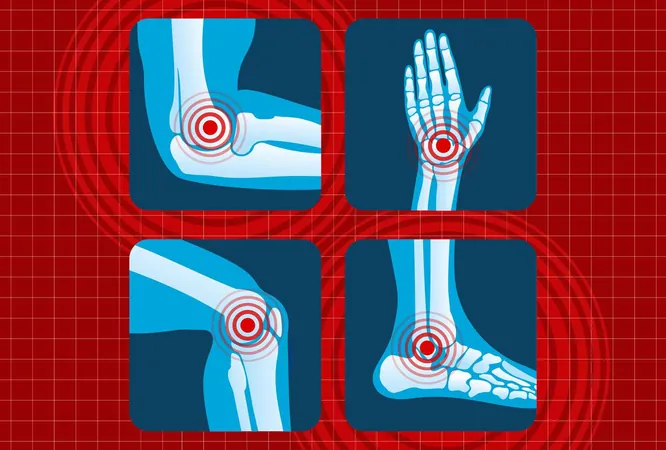
5 Common Arthritis Myths Busted: What Science Really Says
2025-01-11
Author: Ying
Arthritis affects a staggering 53 million adults in the U.S., but did you know that this condition isn't just one disease? The Arthritis Foundation reveals that arthritis encompasses over 100 different types, affecting people of all ages, not just the elderly. Despite its widespread prevalence, misconceptions abound, muddying the waters surrounding its causes, treatments, and management.
To help clear up the confusion, we’ve combed through the latest research to debunk five common myths about arthritis that could be impacting your understanding and approach to this condition.
Myth 1: Arthritis Only Affects Older Adults
Contrary to popular belief, arthritis is not merely a part of aging. Sarah Schlichter, a registered dietitian, points out that almost half of adults with arthritis are below the age of 65. Conditions like juvenile idiopathic arthritis and psoriatic arthritis can even affect children. Factors such as genetics, infections, and injuries play a significant role, showing that arthritis can strike at any age—don’t let the age myth hold you back from seeking help.
Myth 2: Cracking Your Knuckles Causes Arthritis
We've all heard that noisy knuckles can lead to arthritis, but this is just a myth. Research shows no link between knuckle cracking and the development of arthritis. The sound you hear is due to the release of gas bubbles in the joint's synovial fluid. Though it may annoy those around you, cracking knuckles does not damage your joints.
Myth 3: Exercise Makes Arthritis Worse
This is a harmful myth that's keeping many people with arthritis from staying active. In fact, physical activity can significantly alleviate symptoms. Studies suggest exercising strengthens muscles around joints, enhances flexibility, and reduces inflammation. Low-impact activities like swimming and cycling are particularly beneficial. As always, consult with a healthcare provider to tailor an exercise regime that suits you.
Myth 4: All Types of Arthritis Are the Same
Many people lump all forms of arthritis into one category, but this is far from the truth. The two most common types—osteoarthritis and rheumatoid arthritis—have different causes and treatment pathways. Osteoarthritis results from wear and tear on joints, while rheumatoid arthritis is an autoimmune condition. If you're experiencing joint issues, it’s essential to get a proper diagnosis from a medical professional to receive appropriate treatment.
Myth 5: There’s Nothing You Can Do About Arthritis
This myth can be particularly disheartening. While arthritis is chronic and currently incurable, a myriad of strategies exists to help manage pain and enhance quality of life. A focus on anti-inflammatory foods can be particularly beneficial. Dietary changes, such as adopting a Mediterranean diet rich in fatty fish, fruits, vegetables, and whole grains, may reduce symptoms and improve joint health.
Additional Strategies for Managing Arthritis
Stay Active: Engage in low-impact exercises regularly to promote joint health and mobility.
Adopt an Anti-Inflammatory Diet: Incorporate more whole foods that combat inflammation in your meals.
Manage Your Weight: Maintaining a healthy weight can alleviate stress on your joints.
Focus on Stress Management: Chronic conditions can lead to increased stress, which in turn can worsen symptoms. Techniques such as mindfulness and meditation can be very helpful.
The Bottom Line
Arthritis is a multifaceted condition often misunderstood. By debunking prevalent myths, you can take informed steps—whether through exercise, dietary adjustments, or medical treatments—to manage symptoms effectively and reclaim your quality of life. Don’t let misinformation hold you back; arm yourself with knowledge and conquer arthritis head-on!

 Brasil (PT)
Brasil (PT)
 Canada (EN)
Canada (EN)
 Chile (ES)
Chile (ES)
 Česko (CS)
Česko (CS)
 대한민국 (KO)
대한민국 (KO)
 España (ES)
España (ES)
 France (FR)
France (FR)
 Hong Kong (EN)
Hong Kong (EN)
 Italia (IT)
Italia (IT)
 日本 (JA)
日本 (JA)
 Magyarország (HU)
Magyarország (HU)
 Norge (NO)
Norge (NO)
 Polska (PL)
Polska (PL)
 Schweiz (DE)
Schweiz (DE)
 Singapore (EN)
Singapore (EN)
 Sverige (SV)
Sverige (SV)
 Suomi (FI)
Suomi (FI)
 Türkiye (TR)
Türkiye (TR)
 الإمارات العربية المتحدة (AR)
الإمارات العربية المتحدة (AR)